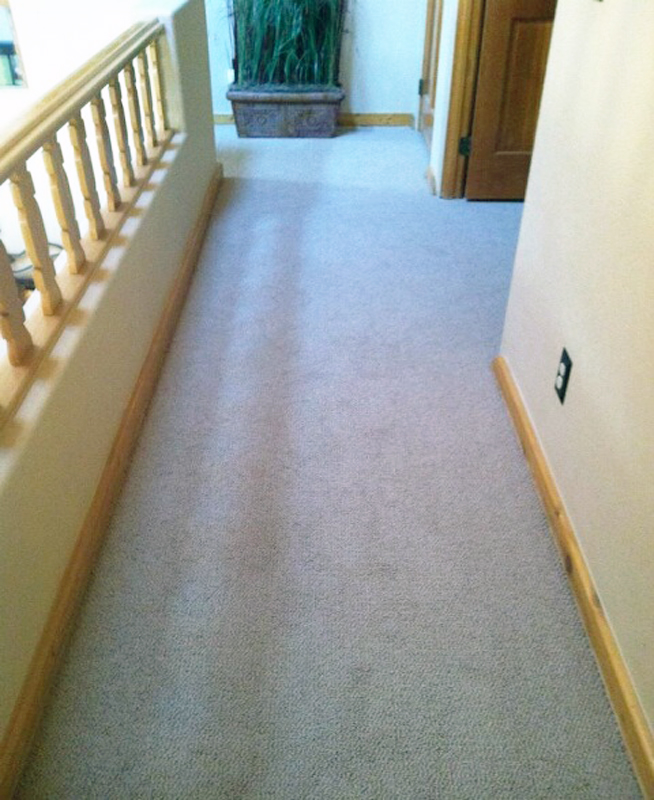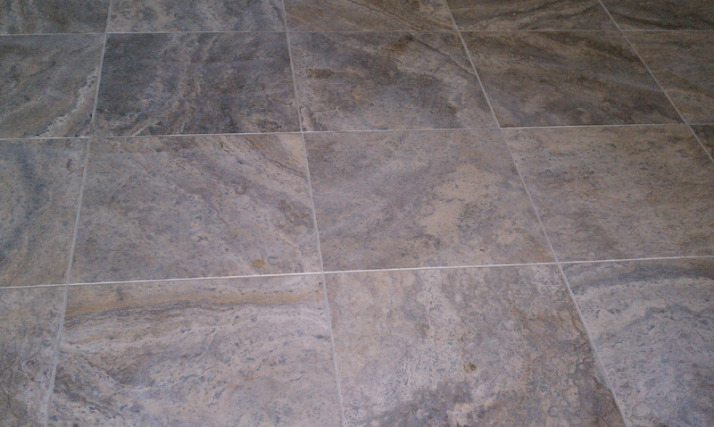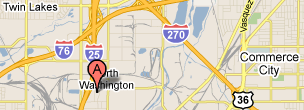Floor Care and Cleaning Guide
Regular care and maintenance of your new flooring is a simple way to extend the life and performance of your investment and keep it looking like new for years. Here are some general guidelines to follow for the different flooring types.
 Carpet
Carpet
Suck it Up: dirt, dust, and other small particles are sharp and abrasive, and when they collect in your carpet, they can rip and tear the fibers over time. Regular vacuuming keeps these particles from wearing away at the carpet, and it also improves its appearance.
Bag it: if you choose a vacuum that uses bags, make sure you change the bag frequently to allow maximum cleaning efficiency - and to avoid all that dust blowing back onto your carpets! Newer bagless models may save time and make the effort even easier.
Watch Your Weight: heavy furniture, potted plants and other home décor can crush carpet pile and leave compressions that you may not notice until you redecorate or move. Use felt pads or protective caps and re-arrange the furniture periodically.
Stay Out of the Sun: in the same way the sun damages our skin, its ultraviolet rays can also damage the color of your carpet over time. To avoid sun lightening to your carpets, shut the curtain or blinds when the sun is most intense or use UV glass or film in your windows.
Snip the Snags: looped carpets tend to snag over time - especially at the seams. It's best not to vacuum over lose yarn or pull at the snags. Instead, treat every loose thread like you would on an expensive suit. Grab scissors and carefully snip the snag flush with the plush.
Watch the Spills: when these events occur begin the clean-up process by using a dry cloth to blot up as much debris or liquid as possible. The longer you wait, the more the fibers will absorb the stain. Warm water should then be used to rinse the stained area. Press the cloth into the carpet to soak up the moisture until the stain is gone. Don't scrub and don't use hot water. You'll damage the fibers. Finally, rinse the area with warm water and absorb the wetness with a dry cloth. After your carpet is dry, vacuum it to restore its texture and appearance. There are some carpet cleaners that do actually work. Ask you retailer about cleaning products that have earned the Carpet & Rug Institute's (CRI) Seal of Approval.
Read Up!: like a fine piece of clothing, carpet is a textile. Though it doesn't come with a little white tag on the back of the neckline, it does come with maintenance literature provided by the manufacturer. Different fibers, styles and finishes require specific care. In the same way you wouldn't throw a silk blouse in the washing machine, you don't want to make a similar mistake with your carpet. Read up and follow the suggested guidelines. You'll be glad you did.
Call the Pros: time and traffic take their toll. It's just a fact of life. Carpet manufacturer warranties have very specific instructions on the type of professional cleaning necessary to keep that warranty in force. Refer to that material. Then, when necessary, call on a reputable carpet cleaning service to restore your rugs to their original luster. The knowledge, commercial equipment and experience of a professional can go a long way towards removing stubborn stains and keeping your home beautiful.
Hardwood Flooring
Meet Mat: tiny particles, like dirt, can act like sandpaper and scratch your wood. By placing a floor mat at each entryway and encouraging family members and guests to wipe their feet, the majority of dirt and grime will remain on the mat. Also put a floor mat or rug in any area where water could be splashed - like near the kitchen sink. This will hinder any possible water damage. Note that rubber-backed or non-ventilated floor mats or rugs can damage your floor. Instead use floor mats or rugs made especially for hardwood floors and be sure to shake them out regularly.
Whistle While You Work: along with a hardwood floor comes the responsibility of keeping it clean. The better care you take, the longer your floor will maintain its original beauty.
- Step #1 - purchase a high quality broom so that you can sweep your floor regularly of dirt, dust and other particles.
- Step #2 - use a vacuum cleaner without a beater bar to get in between the boards and other hard to reach areas. Deeper cleaning techniques vary depending on the installation and finish of your hardwood floor.
For "Finish in Place" hardwood floors, using an 8"x14" terrycloth mop with a rotating head that makes cleaning corners, under cabinets and along base boards easier is recommended. Professional cleaning products recommended by your flooring manufacturer can be used to remove tough stains and spills without dulling the finish of your wood floor. Makers of "Pre-finished" floors recommend their own specific products for routine maintenance.
Do's and Don'ts
- DO use cleaners that won't leave a film or residue
- DO use a professional hardwood floor cleaner to remove occasional scuffs and heel marks (just spray some cleaner on a cloth and rub the stained area lightly)
- DO clean sticky spots with a damp towel or sponge
- DO minimize water exposure and clean spills immediately
- DON'T wax a wood floor with a urethane finish
- DON'T use ammonia cleaners or oil soaps on a wood floor - they'll dull the finish and affect your ability to recoat later.
- DON'T wet mop or use excessive water to clean your floor (wood naturally expands when it's wet and can cause your floor to crack or splinter)
Protect Your Investment - all hardwood floors fade or change shades over time. Like our own skin, wood's exposure to sunlight may greatly increase this process and cause permanent damage.
Window treatments are recommended to shade your floors from the sun's harsh rays. We also recommend rotating area rugs and furniture regularly, allowing wood floors to age evenly from UV exposure. To avoid permanent marks and scratches, it's a good idea to cover furniture and table legs with flannel protectors. Be careful when moving heavy objects across your floor to avoid scuffing. Ladies - your stiletto heels may be fashionable, but what's not in fashion (or covered by your warranty) are the dents and scratches they cause to wood floors. Likewise, trim your pet's nails regularly and keep any and all other sharp objects away from your floors. Love your floors and your floors will you back for a long, long time.
Laminate Flooring
Sweeping & Mopping: dust and dirt act as an abrasive on a laminate's surface and seriously dull its appearance. This fact of life can be avoided by regular sweeping, dust mopping or vacuuming to remove loose dirt and grime. Either a broom or a vacuum cleaner without a beater bar will do the trick. Vacuum cleaner attachments are useful to capture dust and dirt between planks or along edges. An occasional damp mopping is also recommended. But be careful - laminate flooring can expand when it comes in contact with excessive water. After a damp mopping, a clean cloth should be used to wipe the floor dry. Placing doormats at each entryway is also a good idea to collect excessive moisture and dirt before they enter your home.
Do's and Don'ts
- DO use glides or floor protectors on the bottom of furniture to prevent scratching or abrasion
- DO lift heavy furniture instead of dragging or pulling it to avoid scratching and abrasion
- DO use carpet fragments face down under heavy objects when moving them across a laminate floor
- DO your spot cleaning and occasional complete cleaning using the manufacturer's recommended products
- DON'T use soap-based detergents or "mop-and-shine" products
- DON'T use abrasive cleaners, steel wool or scouring powder
- DON'T flood your floor with water or cleaner
- DON'T try to refinish or sand your laminate floor
Repair - replacement laminates may be a slightly different dye lot and/or texture than your original installation. With time and usage, however, the replacement product will blend in with the rest of your floor. With proper care and regular maintenance, laminate flooring will provide you and your home with many years of beauty, warmth and durability.
Vinyl Flooring
Your Mother Was Right: keeping the floor clean is not hard, but there are some guidelines to increase the life of your flooring. Dust, sand and grit particles are the enemy. Sweep or vacuum frequently. Don't use a vacuum with a beater bar as it may scratch your floor and don't use scrub brushes. When sweeping or vacuuming does not remove the dirt, mop the floor with clean warm water. Rinse the floor thoroughly with fresh water. If water alone does not clean the surface, use cleaning products recommended by the manufacturer. Most "no rinse" cleaners will work just fine. An ounce or so of liquid detergent or ammonia in a gallon of water will work, but you will need to rinse the floor well. Do NOT use detergents, abrasive cleaners or "mop and shine" products. And always toss in an ounce of prevention. Mats or rugs in front of outside doors will help keep the dust and grit from getting to the floor in the first place. Be sure the mats and rugs you buy are for vinyl floors. Some rubberbacked mats may leave stains or marks.
It's Just a Spill: for spots or spills, wipe them up immediately and use the same technique on the spot as you would for the whole floor.
Sometimes It's Serious: if you have a seam open up, you need to cover it to keep out the dirt. The same applies if you get a cut or gouge in your new floor. Dirt makes it harder to repair. Call your retailer or installer for information on who should repair the seam.
 Ceramic Tile Flooring
Ceramic Tile Flooring
Sweeping: dirt adheres easily to the surface of ceramic tile, especially styles with textured surfaces. Regular sweeping loosens and removes most dirt. A vacuum cleaner can also be used to sweep, but make sure you use one without a beater bar to avoid dulling and scratching the tiles. Vacuum cleaner attachments are great to suck up dirt along edges or in between tiles.
Mats: use doormats to keep dirt from coming into your home and shake them out often. This will reduce the amount of dirt being tracked across your ceramic tile floor, and reduces the wear to the finished surface.
Mopping: ceramic tile floors should be damp-mopped using manufacturer-recommended grout and tile cleaners. For heavier soil, spot clean the floor with a sponge or clean cloth using the same recommended cleaners.
Heavy Cleaning: mild scrubbing with a soft brush or electric polisher/scrubber may be required for textured tiles. After cleaning with a mild detergent, rinse thoroughly with clean, warm water to remove leftover residue. If necessary, wipe the tile dry with a clean towel to remove any film. For soft water situations, an all-purpose cleaner may be necessary. Apply it to your floor and let it stand for 3-5 minutes. Then lightly scrub with a sponge, rinse well and you're good to go. Cleaning products available from your local grocery or hardware store can be used to remove soap scum, hard water deposits and mildew stains from ceramic tile. Be sure to consult the cleaning product's instructions to ensure the product is recommended for your type of tile. After cleaning, rinse well and wipe dry for a sparkling shine.
Do's and Don'ts
- DO clean up spills as quickly as possible so your grout won't become stained
- DO remember that while ceramic tile is very durable, it's not indestructible and may crack or chip under extreme force
- DO take the proper precautions when moving heavy objects across a ceramic tile floor
- DO cover furniture and table legs with protectors to guard your floor against scratching
- DO remember that if a repair is necessary, the replacement product may be a slightly different dye lot and/or texture than the original tile, however, with time and usage, the replacement tile will blend in with its neighbors.
- DON'T use steel wool, scouring powders, or other abrasives that can scratch the finish of your ceramic tile
- DON'T use bleach or ammonia-based cleaners - these products can discolor your grout if used too often
Caulking and Sealing - once your tile has been laid and grouted, it's your responsibility to caulk areas that may be exposed to water. Caulking will prevent expensive subsurface damage and keep the tiled areas looking as good as new. Depending on your lifestyle, sealing your tile and grout may also be an option. After installation, sealing the grout and tile can provide protection from dirt and spills by slowing down the staining process. Grout colorants can transform the original color of your grout and, in some cases, can act as a form of sealant. Be aware that non-epoxy grout joints should be treated with a silicone sealer. Regular care and maintenance will keep your ceramic tile floors looking their very best for years to come.
Area Rugs
You should vacuum or sweep your area rug as you would wall-to-wall carpeting. Watch the fringes. You don't want to have to pull them out of the vacuum cleaner. Handmade area rugs can benefit from being turned over and vacuumed. Lift the rug up carefully and you will see all the dirt that had filtered down.
Turn, Turn, Turn: rotating your rug occasionally (annually) will help even wear patterns and prevent uneven fading. When rugs are exposed to the sun evenly, the colors harmonize and the rug ages nicely. If parts of the rug receive too much or too little of sun, one side might fade faster than the other.
See Spot? Go!: clean your area rug immediately after a spill. A water spill should be dried with a hair dryer set on a warm temperature. Try to dry both sides of the rug if possible. Anything else should first be blotted with paper towels to absorb as much as possible, and then apply salt or baking soda to the spot for a few minutes to absorb the rest. Once it dries, vacuum off the salt or baking soda. Professional grade rug cleaners are available. Be sure to test for color fastness before using. Take the rug to a professional handmade rug cleaner to deal with old or persistent stains. Do not try to clean it yourself. You might make it worse!
Read the Labels and Listen to the Pros: if you purchased a handmade rug, it's best to have it cleaned by professionals. If you have a machine made rug, look to the manufacturer for the best way to clean it. Some can be machine washed. Others can be scrubbed by hand and dried outside.
Does Your Pad Need Padding?: consult with your retailer about the proper padding to be placed under the rug you choose. A pad can help stabilize and protect your rug. Some rugs come with a non-skid backing or a nice foam padding already attached.
Storing: if your area rug needs to be stored for a long time in a place without exposure to light or air, first vacuum it or get it professionally cleaned. For handmade rugs and those made of natural fibers, you might consider packing it with mothballs to protect against insect damage. Never fold your rug - roll it and store it in a dry location.
Rug Repair - repairing a handmade rug is an art form in and of itself. It is time consuming and labor intensive and therefore, often costly. Get the opinion of a professional before you have work done on a handmade rug - and be sure to use a reputable repairman.
 Stone Flooring
Stone Flooring
It's Its Own Worst Enemy: sand, grit, and dirt can damage natural stone surfaces because they are abrasive. Use a vacuum on your floor if it's textured, but avoid the beater bar. Those bristles are tough and might scratch your flooring. An old-fashioned dust mop works well, as does a broom. Wet mop as needed.
Be Proactive: walk-off mats or area rugs on either side of entrances from the outside will help collect dirt before it reaches your beautiful new floor. Choose a rug or mat with a non-slip surface.
There's Clean and There's Cleaner: Damp mopping your natural stone floor will keep it looking beautiful. But your retailer or manufacturer can suggest special cleaners meant specifically for stone floors. Wipe up spills immediately. Use soap, not detergent, for good-old fashioned mopping. Liquid Ivory or a Castile soap product work well. Too much cleaner or soap may leave a film and cause streaks, so rinse well. Change your rinse water frequently. Don't use products that contain lemon juice, vinegar or other acids on marble, limestone, or travertine. Avoid abrasive cleaners or any ammonia based cleaners. These products will dull the floor's luster. Retail grout cleaners, scouring powders or bathroom tub and tile cleaners can mar the finish on your stone. Never mix bleach and ammonia. The combination creates a toxic gas. To remove algae or moss from your stone in outdoor pool, patio or hot tub areas, flush with clear water and use a mild bleach solution.
Green Flooring 
Green Tips for Adhesives:
- Choose products with low to no VOCs (Volatile Organic Compounds)
- Avoid formaldehyde
- Look for Carpet and Rug Institure's (CRI) Green Label® or Green Label Plus® certification
Green Tips for Cleaners:
- Choose products with natural and biodegradable ingredients
- Consider homemade cleaners using things from the pantry: vinegar, baking, soda, salt, lemon juice, rubbing alcohol, ammonia, or olive oil
Green Tips for the Whole House:
- Keep caulked areas caulked (caulking prevents the loss of heat or cold air)
- If you are installing a new floor, make sure that space between the flooring and the door is just right (too much space means you're heating or cooling the entire outdoors while too little space means you can't close the door)
- Consider that space heaters are energy hogs and can generate more than two pounds of greenhouse gas per hour (use them too much and they might make your hardwood floors contract)
- Choose low or no VOC products whenever you can
- Insulation is not just for the attic anymore, it can be added between floors for additional saving
- Choose a retailer that shares your commitment to the environment and knows about all the latest advances in green products.
 Product Guides | tagged
Product Guides | tagged  CRI,
CRI,  Care & Maintenance,
Care & Maintenance,  Carpet,
Carpet,  Cleaning,
Cleaning,  Flooring,
Flooring,  Laminate,
Laminate,  Rugs,
Rugs,  Stone,
Stone,  Vinyl,
Vinyl,  WFCA |
WFCA |  1 Reference |
1 Reference |  1 Comment |
1 Comment |  Email Article | |
Email Article | |  Print Article
Print Article 


















